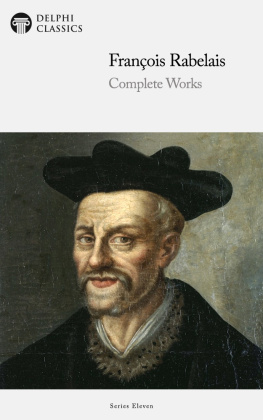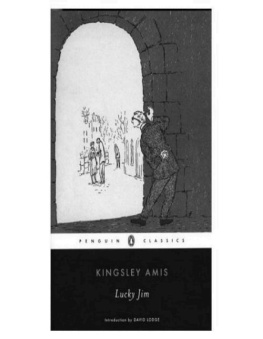Francois Rabelais - Gargantua and Pantagruel (Penguin Classics)
Here you can read online Francois Rabelais - Gargantua and Pantagruel (Penguin Classics) full text of the book (entire story) in english for free. Download pdf and epub, get meaning, cover and reviews about this ebook. year: 2006, publisher: Penguin Classics, genre: Detective and thriller. Description of the work, (preface) as well as reviews are available. Best literature library LitArk.com created for fans of good reading and offers a wide selection of genres:
Romance novel
Science fiction
Adventure
Detective
Science
History
Home and family
Prose
Art
Politics
Computer
Non-fiction
Religion
Business
Children
Humor
Choose a favorite category and find really read worthwhile books. Enjoy immersion in the world of imagination, feel the emotions of the characters or learn something new for yourself, make an fascinating discovery.
- Book:Gargantua and Pantagruel (Penguin Classics)
- Author:
- Publisher:Penguin Classics
- Genre:
- Year:2006
- Rating:5 / 5
- Favourites:Add to favourites
- Your mark:
- 100
- 1
- 2
- 3
- 4
- 5
Gargantua and Pantagruel (Penguin Classics): summary, description and annotation
We offer to read an annotation, description, summary or preface (depends on what the author of the book "Gargantua and Pantagruel (Penguin Classics)" wrote himself). If you haven't found the necessary information about the book — write in the comments, we will try to find it.
Gargantua and Pantagruel (Penguin Classics) — read online for free the complete book (whole text) full work
Below is the text of the book, divided by pages. System saving the place of the last page read, allows you to conveniently read the book "Gargantua and Pantagruel (Penguin Classics)" online for free, without having to search again every time where you left off. Put a bookmark, and you can go to the page where you finished reading at any time.
Font size:
Interval:
Bookmark:

GARGANTUA AND PANTAGRUEL
FRANOIS RABELAIS , born in the 1480s, is very much a Renaissance man. As a Franciscan turned Benedictine he studied Law; he graduated as a doctor at Montpellier in 1530. Living irregularly, he published in 1532 the first of his comic Chronicles, Pantagruel ; it revealed his genius as a storyteller and creator of comic characters and situations. By early 1535 he had published Gargantua , outrageously mocking old-fashioned education and rash imperialism. Against monastic ideals it opposes an Abbey where noblemen and ladies live in evangelical freedom and Renaissance splendour. In January 1535 Rabelais fled from his post as physician in Lyons. His profound and audacious Third Book was published in 1546. He was then a secular priest. He fled to Metz. His Fourth Book , published in January 1552 not long before he died, contains some of his deepest, boldest and funniest pages. It enjoyed the public support of the King and two Cardinals. (It outlived the Index of Prohibited Books on which it was eventually placed.) A Fifth Book appeared under his name in 1564. His genius was acknowledged in his own day: his world-wide influence remains enormous.
M. A. SCREECH is an Honorary Fellow of Wolfson College and an Emeritus Fellow of All Souls College, Oxford, a Fellow of the British Academy and of the Royal Society of Literature, a Fellow of University College London, and a corresponding member of the Institut de France. He long served on the committee of the Warburg Institute as the Fielden Professor of French Language and Literature in London, until his election to All Souls. He is a Renaissance scholar of international renown. He has edited and translated both the complete edition and a selection of Montaignes Essays for Penguin Classics and, also, in a separate volume, the Apology for Raymond Sebond . His other books include Erasmus: Ecstacy and the Praise of Folly (Penguin, 1988), Rabelais, Montaigne and Melancholy (Penguin, 1991) and, most recently, Laughter at the Foot of the Cross (Allen Lane, 1998). All are acknowledged to be classic studies in their fields. He worked with Anne Screech on Erasmus Annotations on the New Testament . Michael Screech was promoted Chevalier dans lOrdre du Mrite in 1982 and Chevalier dans la Lgion dHonneur in 1992. He was ordained in 1993 by the Bishop of Oxford.
FRANOIS RABELAIS
Gargantua and Pantagruel
Translated and edited
with an Introduction and Notes by
M. A. SCREECH
PENGUIN BOOKS
PENGUIN BOOKS
Published by the Penguin Group
Penguin Books Ltd, 80 Strand, London WC2R 0RL , England
Penguin Group (USA) Inc., 375 Hudson Street, New York, New York 10014, USA
Penguin Group (Canada), 90 Eglinton Avenue East, Suite 700, Toronto, Ontario, Canada M4P 2Y3
(a division of Pearson Penguin Canada Inc.)
Penguin Ireland, 25 St Stephens Green, Dublin 2, Ireland
(a division of Penguin Books Ltd)
Penguin Group (Australia), 250 Camberwell Road, Camberwell, Victoria 3124, Australia
(a division of Pearson Australia Group Pty Ltd)
Penguin Books India Pvt Ltd, 11 Community Centre, Panchsheel Park, New Delhi 110 017, India
Penguin Group (NZ), 67 Apollo Drive, Mairangi Bay, Auckland 1310, New Zealand
(a division of Pearson New Zealand Ltd)
Penguin Books (South Africa) (Pty) Ltd, 24 Sturdee Avenue, Rosebank, Johannesburg 2196, South Africa
Penguin Books Ltd, Registered Offices: 80 Strand, London WC2R 0RL , England
www.penguin.com
This translation first published in Penguin Classics 2006
3
Translation, Introduction and Notes copyright M. A. Screech, 2006
All rights reserved
The moral right of the translator has been asserted
Except in the United States of America, this book is sold subject to the condition that it shall not, by way of trade or otherwise, be lent, re-sold, hired out, or otherwise circulated without the publishers prior consent in any form of binding or cover other than that in which it is published and without a similar condition including this condition being imposed on the subsequent purchaser
ISBN:978-0-14-193578-2
Contents
Chronology
1483 Possible date for the birth of Rabelais at La Devinire near Chinon. (An alternative date of 1494 is not well supported.)15001510 Some time during these years Rabelais studies law, perhaps at Bourges, Angers and/or Poitiers.151026 Rabelais, previously a novice and lay-brother (possibly in the Franciscan convent at La Baumette), is ordained priest, either there or at the Franciscan abbey of Le Puy-Saint-Martin near Fontenay-le-Comte, where he remains until 1526.1520 Rabelais, a Franciscan at Fontenay-le-Comte, writes his first (lost) letter to Guillaume Bud.1521 Second letter of Rabelais to Bud.1522 Amaury Bouchard publishes Of the Female Sex, against Andr Tiraqueau . Rabelais remains friends with both Bouchard and Tiraqueau.15234 Rabelais, in trouble with his superiors for studying Greek, has already translated into Latin the first book of Herodotus and some works of Lucian. He is supported by his bishop, Geoffroy dEstissac. Rabelais ceases to be a mendicant friar and becomes a monk (a Benedictine).15246 Based at the Benedictine house at Saint-Pierre-de-Maillezais, Rabelais works for, and travels with, his bishop.1525 Rabelais possibly in Lyons.February: A disastrous defeat for the French at Pavia. Franois I is prisoner in Madrid.1526 By the Peace of Madrid, Franois I is released from captivity and the royal sons are kept as hostages for his ransom. Milan is ceded to Charles V.152630 Rabelais leaves Poitou. He studies the great Greek medical authorities (Hippocrates and Galen), probably in Paris. Two of his three children, Franois and Junie Rabelais, perhaps born during this period.1528 Late summer sees the beginning of over five years of disastrous drought in large parts of France.1529 The Peace of Cambrai: the royal sons are to be released against a ransom of 2 million crowns.1530 Rabelais signs the matriculation rolls at Montpellier and quickly graduates as Bachelor of Medicine.153032 Rabelais in Montpellier.1531 Rabelais lectures at Montpellier on the Aphorisms of Hippocrates and Galens Ars Parva .May: The Paris Parlement consolidates its powers over the Sorbonnes right to censor books.1532 Rabelais, in the University of Montpellier, acts in The Farce of the Man Who Married a Dumb Wife . Practises medicine in the Midi, including Narbonne; by June, he is established in Lyons.Dedicates his edition of Manardis Epistolae Medicinales to Tiraqueau, his edition of works of Galen and Hippocrates to Bishop Geoffroy dEstissac and his edition of Lucius Cuspidius Testamentum to Amaury Bouchard. First edition of Pantagruel (if not in 1531). Appointed physician to the Htel-Dieu in November, the great hospital in Lyons, Rabelais publishes his Almanac for the year 1533 . Writes to Erasmus; the letter is sent with a Greek manuscript of Josephus sought by Erasmus. The Pantagrueline Prognostication for 1533.1533 February: Permission is given to wear masks in the streets of Paris during the Shrovetide revels. Anti-Lutheran demonstrations and sermons are orchestrated by the Sorbonne.May: An attempt by the Sorbonne to censor The Mirror of the Sinful Soul of Marguerite de Navarre as well as Pantagruel . The Sorbonne theologians Bda, Picart and Leclerc are exiled twenty leagues from Paris. Critical posters ( placards) are displayed in Paris. Reprisals.July: The Sorbonne authorizes Nicolas Bouchart and Louis Thobald to supplicate Franois I on behalf of Bda. They are unsuccessful.October: The Sorbonne denies ever having intended to censor The Mirror of the Sinful Soul .Rabelais publishes an augmented Pantagruel and the Pantagrueline Prognostication for 1534.The plague, endemic in Europe, spreads. Rabelais is praised for his devotion to his patients.1534 Rabelais leaves for Rome with Bishop Jean Du Bellay, possibly entrusting a manuscript of Gargantua to Franois Juste in Lyons. He leaves Rome in March.April: Rabelais in Lyons with Jean Du Bellay (who goes on to Paris). Rabelais movements unknown between April and July. Gargantua , if not already published, now in hand.August: Rabelais resumes his post as physician in the Htel-Dieu. He dedicates his edition of Marlianis Topographia Romae to Jean Du Bellay.October: The (first) Affaire des Placards (1718 October). Posters (now known to be Zwinglian) attack the Mass as idolatry. Repression follows.November-December: The publication of the Almanac for the Year 1535 and the expanded Pantagrueline Prognostication for 1535, critical of the suppression of Evangelicals.1535 The Affaire du 13 janvier: a rash repeat of the Placards of October 1534. Violent repercussions. Many flee. All printing is forbidden but later restored through the influence of Guillaume Bud and the Du Bellays. A great national act of expiation led by Franois I; the Du Bellays remain in favour. Heretics are burnt.January: The probable date for the publication of Gargantua . Rabelais son Thodule, born about this time (?). Pantagruel published without the permission of Rabelais by the printer Saincte-Lucie dit Le Prince in Lyons.February: Guillaume Du Bellay publishes for Franois I a letter to the German states defending the French alliance with the Turks even while heresy is suppressed at home. Bdas amende honorable before Notre-Dame-de-Paris; he is exiled once and for all to Mont-Saint-Michel.Rabelais abandons his post in the Htel-Dieu, Lyons; he publishes his Almanac for 1536 .May: Jean Du Bellay is named cardinal, amidst accusations of Lutheranism.June: Franois I invites Melanchthon to Paris.Jean Du Bellay and Rabelais in Rome: they may have travelled there together, passing through Ferrara. The second edition of Gargantua , specifically dated 1535, may have been left en route in Lyons with Franois Juste.15356 Rabelais arranges a papal absolution for his apostasy.1536 February: Rabelais is installed in Jean Du Bellays Benedictine abbey at Saint-Maur-les-Fosss; it is secularized, and Rabelais with it. A papal brief authorizes him to practise medicine. He is now a secular priest, a father.August: Rabelais figures among the canons of Saint-Maur.1537 During this year, Pantagruel and Gargantua republished in Lyons and Paris.January: Bda dies in exile at Mont-Saint-Michel.February: Rabelais at a celebratory banquet in Paris with Etienne Dolet, Bud, Marot, Danes, Macrin, Bourbon and others.April: Rabelais graduates, in Montpellier, as a licenci (a step towards his full Doctorate of Medicine).May: Rabelais becomes a Doctor of Medicine.June-September: Rabelais possibly in Lyons.August: Guillaume Du Bellay passes through Lyons on his way to govern the Piedmont. Rabelais joins him.October: Rabelais lectures at Montpellier on the Prognostics of Hippocrates. The course lasts until April 1538.November: Rabelais presides over a public dissection performed as a lesson in anatomy.1538 Fresh severe measures decreed against heresy in France.Summer: Rabelais in Montpellier, from where he joins Guillaume Du Bellay (now the Governor of the Piedmont) in Turin. Publishes his Stratagemata , praising the military prowess of Guillaume Du Bellay. No copy is known.First edition of the anonymous Panurge disciple de Pantagruel (seven editions follow, variously named).153840 Rabelais possibly in Lyons. He may have made a visit to Bordeaux. His son Thodule may have been born in this period, rather than 1535.1540 Rabelais children Franois and Junie relieved of the stigma of illegitimacy by the papal curia.December: Rabelais back in France (via Chambry). Publishes an Almanac for 1541.154042 Rabelais in Piedmont with Guillaume Du Bellay.1541 Rabelais returns to France in November (when Guillaume Du Bellay reports on Piedmont).1542 Guillaume Postel violently attacks Rabelais in print. Rabelais will mock him in his Fourth Book .April: Rabelais passes through Lyons en route for Turin with Guillaume Du Bellay. The revised Pantagruel , published by Franois Juste, dates from this period. Etienne Dolet brings out a pirate edition without the revisions made by Rabelais. During his various stays in Italy Rabelais reads Celio Calcagnini, the mythographer.November: Guillaume Du Bellay, ill, includes Rabelais amongst the beneficiaries of his will. He leaves Turin for France in December. Rabelais is with him.1543 January: Guillaume Du Bellay dies near Roanne. Rabelais is present and escorts the body home.March: Gargantua and Pantagruel figure on the list of censorable books drawn up by the Sorbonne for the Paris Parlement. Rabelais is present (with Ronsard and others) at burial of Guillaume Du Bellay in the Cathedral of Le Mans.1544 August: The Sorbonnes revised list of censorable books is sent to the printers: Rabelais figures in it.1545 January: Franois Bribart, secretary of Jean Du Bellay, burnt at the stake.April: The massacre of the Vaudois.September: Franois I provides the royal privilge for the Third Book of Pantagruel (signed by Delauney).1546 Before Easter: The Third Book printed by Christian Wechel (Paris). At least three other printings follow.Rabelais discreetly slips away to Metz. He is appointed Physician to the City. He reads works of Luther.August: Etienne Dolet is burnt in the Place Maubert. Jean Du Bellay exchanges his bishopric of Paris for that of Le Mans (which is better than Paris for his health).December: The expanded catalogue of books censored since May 1544 is published; it includes the Third Book of Pantagruel .1547 April: Henri II succeeds to the throne. Jean Du Bellay remains in favour.June: After the coronation of Henri II at Rheims, Jean Du Bellay leaves for Rome.Probably the last of the payments to Rabelais as physician in Metz. He travels from Metz to Rome, possibly leaving the partial Fourth Book with Pierre de Tours in Lyons. Remains in Italy until 1549.1548 During this year, there are at least two printings of the partial Fourth Book .June: Rabelais in Rome.1549 February: The birth of Louis of Orleans, second son of Henry II.March: The festivities held in Rome in honour of Henry II are described by Rabelais in his Sciomachie .September: Jean Du Bellay leaves Rome. Violent attack on Rabelais in a work, Theotimus , by an important theologian of the Sorbonne, Gabriel Dupuyherbault, whom Rabelais will mock in his Fourth Book .1550 AugustOctober: Rabelais is at Saint-Maur with Jean Du Bellay (convalescent). He meets the Cardinal Odet de Chtillon, who assures him of the royal favour and of his own support.August: The royal privilge for all of Rabelais works granted in the presence of Odet de Chtillon. Calvin attacks Rabelais in his Treatise on Scandals .1551 The Sorbonne publishes a list of censored books which includes editions of Pantagruel, Gargantua and the Third Book .Rabelais enjoys two benefices: Meudon and Saint-Christophe-du-Jambet (Sarthe). He does not reside.1552 January: The Fourth Book is printed by Fezandat in Paris; it contains a Preliminary Epistle addressed to Cardinal Odet de Chtillon.March: The Paris Parlement condemns the new Fourth Book at the request of the Sorbonne. It provisionally forbids the sale of the Fourth Book pending directions from the king.April: The triumphant entry of Henry II into Metz. Fezan-dat reprints two pages of the Fourth Book to insert a eulogy of the French victories.October: (Untrue) rumour that Rabelais is in prison.1553 January: Rabelais resigns his benefices at Meudon and Saint-Christoph-du-Jambet.Before 14 March: Rabelais dies in La Rue des Jardins in Paris. He is buried in the cemetery of St Pauls Church.1555 October: Calvin attacks Rabelais in a sermon.1562 The Isle Sonante is published.1564 Publication of the Fifth Book .The Council of Trent concludes and publishes the Index Librorum Prohibitorum , which places Rabelais at the head of the heretics of the first class.Next pageFont size:
Interval:
Bookmark:
Similar books «Gargantua and Pantagruel (Penguin Classics)»
Look at similar books to Gargantua and Pantagruel (Penguin Classics). We have selected literature similar in name and meaning in the hope of providing readers with more options to find new, interesting, not yet read works.
Discussion, reviews of the book Gargantua and Pantagruel (Penguin Classics) and just readers' own opinions. Leave your comments, write what you think about the work, its meaning or the main characters. Specify what exactly you liked and what you didn't like, and why you think so.










